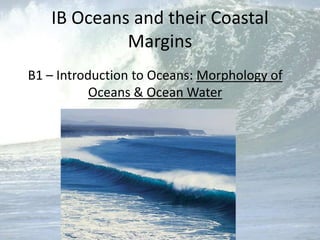
IB Guide to Ocean Morphology and Water Properties
- 1. IB Oceans and their Coastal Margins B1 – Introduction to Oceans: Morphology of Oceans & Ocean Water
- 2. Morphology of Oceans B1 – Introduction to Oceans
- 3. Seamounts – extinct volcanic cones that lie below the surface. Guyot - a flat topped volcano that once reached the surface but later subsided.
- 4. Abysall Plain - at the edge of the continental slope. These plains cover large areas of the sea floor at depths of between 4000m and 6000m. They are generally flat and featureless.
- 5. Abysall Plain - at the edge of the continental slope. These plains cover large areas of the sea floor at depths of between 4000m and 6000m. They are generally flat and featureless.
- 6. Continental Slope- the steeply sloping area of the seabed that stretches from the continental shelf to the abyssal plain.
- 7. Submarine Canyon – steep sided valley on the sea floor of a continental slope. Often (but not always) found as extensions to larger rivers. Submarine canyons are thought to be major conduits for sediment movement from the continents into the deep-sea.
- 9. Ocean Trenches The deepest part of the oceans. Arc-shaped depressions, formed at subduction zones where one tectonic plate plunges under another one. Usually a dense oceanic plate going under a less dense continental one.
- 11. Mid-Ocean Ridges The largest feature of the ocean floor. Linear belt of submarine mountains. New magma forces its way up between two plates and pushes them apart. The rate of spreading at the mid Atlantic ridge is 5 cm a year.
- 13. Continental Shelf Relatively flat area of seabed, stretching from the land to the edge of the continental slope. The continental shelf is less than 250m deep and may be up to 70 km wide.
- 14. OCEANIC WATER B1 – Introduction to Oceans
- 15. Variations in Ocean Temperature Temperature in the oceans is not always constant. Ocean temperature not only varies through the seasons but also by latitude. Sea surface temperature usually recorded remotely by satellite.
- 16. f Sea Surface Temperature Impact of currents can be seen: - Western side of continents shows cooler water heading towards equator.
- 17. ---- Ocean water also varies with depth: Temperature Salinity Ocean waters varies seasonally up to depths of 500 – 1000 metres.
- 18. ------- A boundary usually occurs at a depth of between 200 and 800m called the thermocline; below that surface waters don’t mix. 90% of the total volume of ocean water is found below the thermocline.
- 19. Other Changes with Depth Density of ocean water increases constantly with decreasing temperature until the water freezes. Ocean water is saline therefore its normal freezing temperature is -1.94°C; significantly cooler than pure water. As sea water freezes it usually rejects some of the salt; therefore is only 1% saline; where as sea water is 3.5% saline.
- 20. Salinity and density show the opposite trend to water as the depth of ocean water increases. Temperature declines with increasing depth but salinity and water density both increase. Salinity show a rapid increase at the same time temperature falls rapidly. This increase of salinity is called the halocine. At the same depth the water density also increases rapidly in the same zone which is referred to as the pycnocline.
- 21. Tropical Areas These changes are most noticeable at the tropical areas. The surface temperatures are warmer in the equatorial areas. At great depths the temperature of ocean water shows very little variation.
- 22. Changes with Latitude - Salinity Average salinity is 35 parts per thousand. Concentrations of salt are higher in warm seas, due to high rates of evaporation of water. In polar seas where there is an input of fresh water from rivers salinity is low.
Editor's Notes
- http://www.learner.org/courses/envsci/visual/img_lrg/sea_surface_temperature.jpg